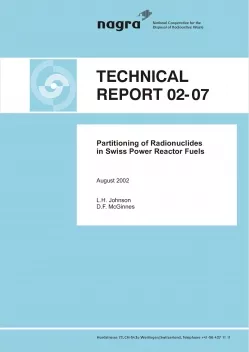
Technical Report NTB 02-07
Partitioning of Radionuclides in Swiss Power Reactor Fuels
The potential preferential release of some fission and activation products from spent nuclear fuel into porewater after canister breaching in a deep repository in Switzerland is discussed. Data from studies of fission gas release from UO2 and mixed oxide (MOX) fuels that are representative of fuel from Swiss nuclear power reactors are used to estimate the average fission gas release (FGR) for spent fuel. The evaluations are performed for average burnup UO2 and MOX fuel (48 GWd/tIHM) as well as for higher burnup fuels (MOX 65 and UO2 55, 65 and 75 GWd/tIHM). For the case of UO2 fuel, the estimates include an analysis of the fraction of FGR present in the rim region, which is particularly important at higher burnup. Information from a variety of leaching studies on LWR fuel are then reviewed and compared to FGR as a basis for estimating the fraction of the inventory of key radionuclides that could be released preferentially (the Instant Release Fraction or IRF) upon breaching of the fuel cladding. For higher burnup fuels, where leaching data are largely unavailable, IRF values are based on extrapolations of FGR behaviour observed at lower burnup and on an assessment of the impact of fuel restructuring at higher burnup on FGR. The IRF thus includes releases from the fuel/cladding gap and grain boundaries, as well as from the rim region. The expected release rates of radionuclides from Zircaloy cladding are also discussed, based on review of low temperature corrosion and radionuclide release data relevant to repository conditions.
